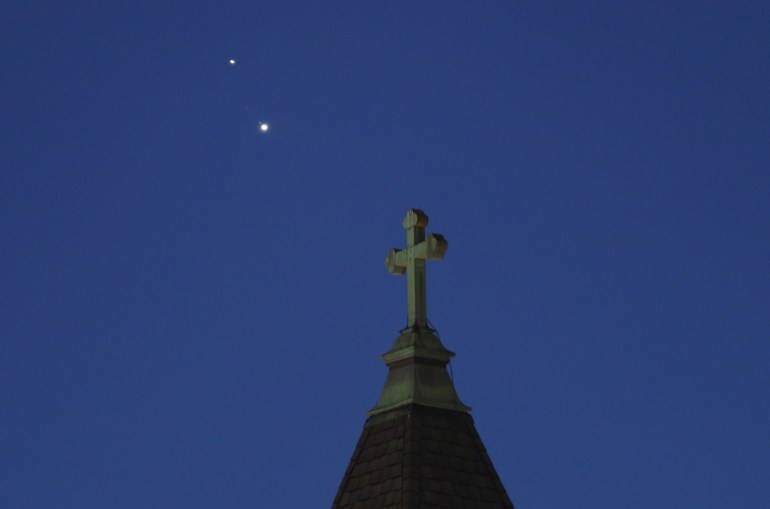Jupiter and Saturn in rare celestial ‘Great Conjunction’
Solar system’s two biggest planets come within planetary kissing range, an intimacy that will not occur again until 2080.

The evening sky over the Northern Hemisphere treated stargazers to a once-in-a-lifetime illusion on Monday as the solar system’s two biggest planets appeared to meet in a celestial alignment that astronomers call the “Great Conjunction” – a planetary intimacy that will not occur again until 2080.
The rare spectacle resulted from a near convergence of the orbits of Jupiter and Saturn that happened to coincide with the Northern Hemisphere’s winter solstice, the shortest day of the year.
Keep reading
list of 3 itemsIn Pictures: 50th anniversary of Apollo 13’s dramatic mission
SpaceX prototype rocket destroyed in explosive test launch
For those able to observe the alignment in clear skies, the two frozen-gas spheres appeared closer and more vibrant – almost as a single point of light – than at any time in 800 years even though they were, in fact, more than 730 million kilometres (400 million miles) apart.
Optimal conjunction took place at 18:22 GMT.

The best viewing conditions on Monday were in clear skies and close to the Equator.
Astronomers suggested the best way to watch the conjunction was by looking towards the southwest in an open area about an hour after sunset.
“Big telescopes don’t help that much, modest binoculars are perfect, and even the eyeball is okay for seeing that they are right together,” Jonathan McDowell, an astronomer at the Harvard-Smithsonian Center for Astrophysics, wrote in an email to Reuters.
Hundreds of space fans also gathered in India’s Kolkata city to watch through a telescope at a technology museum in the city, or from surrounding rooftops and open areas.
And in Kuwait, astrophotographers travelled into the desert west of Kuwait City to capture the once-in-a-lifetime event.
Looking through a telescope or even a good pair of binoculars, Jupiter and Saturn were separated by no more than a fifth of the diameter of a full moon.
But with the naked eye, they would merge into a “highly luminous” double planet, said Florent Deleflie from the Paris Observatory.
“The Grand Conjunction refers to the period when two planets have relatively similar positions in relation to Earth,” said Deleflie.
“With a small instrument – even a small pair of binoculars – people can see Jupiter’s equatorial bands and its main satellites and Saturn’s rings.”

The last time Jupiter and Saturn nuzzled up this close was in 1623, but weather conditions in regions where the event could be seen blocked the view.
Visibility was apparently better the time before that long before telescopes were invented, in 1226, halfway through the construction of the Notre Dame cathedral in Paris.
Jupiter, which is the larger planet, takes 12 years to revolve around the sun, while Saturn takes 29 years.
Every 20 years or so, they appear to observers on Earth to come closer to each other.
The next Great Conjunction between the two planets – although not nearly as close together – is due in November 2040. An alignment similar to Monday’s will not take place until March 2080, McDowell said.
